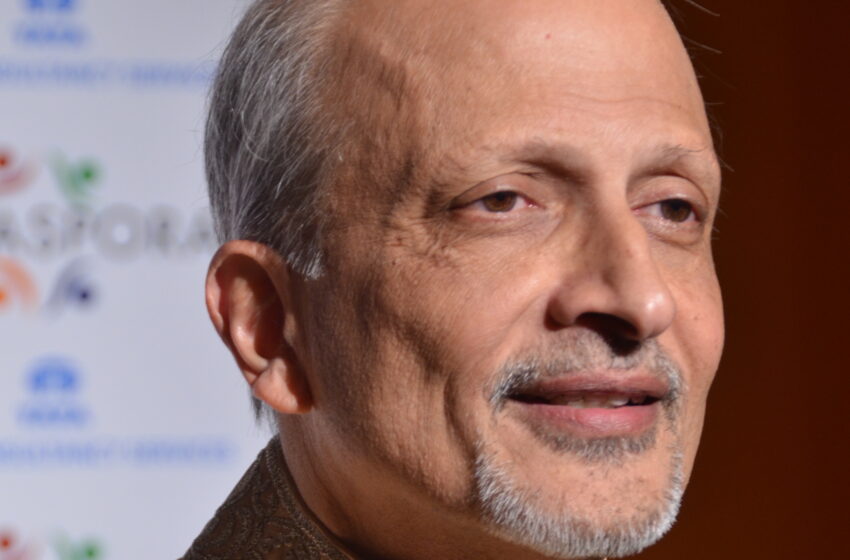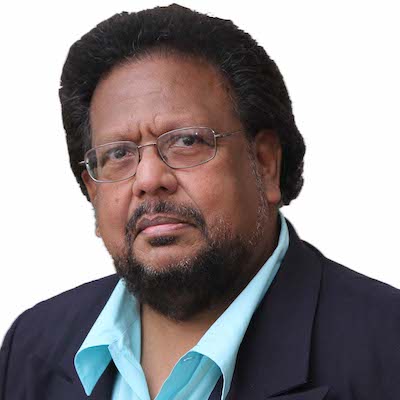M.R. Rangaswami: From angel investor to launching Indiaspora

Indiaspora founder M.R. Rangaswami at the inaugural ball hosted by the organization, the first-ever by a South Asian American group, in Washington, DC. The event took place the night before President Barack Obama’s second inauguration in January 2013. (Photo credit: Shahi Prabhakaran, American Bazaar)
M.R. Rangaswami’s journey to America in 1976 was more than a mere relocation; it was an odyssey marked by uncertainty and a fervent pursuit of new beginnings.
Disenchanted by the state of affairs in India during the emergency, Rangaswami, then a law student, felt compelled to explore new horizons. An invitation from his brother to upstate New York catalyzed a journey that would reshape the course of his life.
Rangaswami, an angel investor and founder of Indiaspora, reflects on his American journey in a recent episode of The Trailblazers, an interview series streamed on the DesiMax YouTube channel.
In the 34-minute interview with DesiMax co-founder Aziz Haniffa, the San Francisco resident reminisces about his early experiences, discusses the evolution of his career, and delves into the founding and impact of Indiaspora — a global organization engaging Indian diaspora leaders worldwide.
READ: M.R. Rangaswami gets Canada-India Business Council’s ‘Global Service Award’ (October 29, 2020)
Arriving in New York City with only $8 in his wallet — the maximum amount Indians could carry due to strict foreign exchange regulations while traveling abroad — Rangaswami’s journey epitomized the trials and resilience of countless immigrants of that era, all striving to carve out a brighter future.
With no smartphones or instant communication, finding his way to his brother’s friend’s home in New Jersey became an adventure in itself. From there, a Greyhound bus journey to Upstate New York awaited him, offering him a firsthand glimpse of the sprawling landscapes and bustling cities of America.
His subsequent pursuit of an MBA at Kent State University in Ohio introduced him to an entirely new world. Nevertheless, the recessionary job market in Ohio propelled Rangaswami to seek better prospects, ultimately leading him to Houston, Texas, where opportunities in the thriving oil industry beckoned.
The camaraderie and support of friends in Houston proved invaluable during his transition, showcasing the solidarity and mutual assistance prevalent among immigrant communities. However, it was Silicon Valley that held the promise of a new frontier for Rangaswami.
READ: Indiaspora founder M.R. Rangaswami bestowed the inaugural Asians in America Award (March 18, 2016)
Encouraged by a serendipitous encounter with a consultant, he set his sights on the epicenter of technological innovation. With determination and a burgeoning interest in computer science, Rangaswami embarked on a quest to join the ranks of Silicon Valley’s tech titans.
In his first job in his new hometown, which was with a startup, Rangaswami encountered the dynamic nature of Silicon Valley. “This company went up and up and up,” he reminisces. “In three years, it went from a million [dollars] to $10 million. It was a great company and then it went chapter 11.”
Following this venture, he transitioned to Deloitte, assuming the role of a management consultant. However, a pivotal phone call from a former boss again redirected his career path. This ex-boss, now affiliated with a growing startup named Oracle, extended an enticing proposition to Rangaswami.
“You know what? This guy Larry Ellison … needs people who are experts in application software, manufacturing, financial, human resource applications. You know all that stuff, and so why don’t you come work with us?” his former boss suggested.
The call led Rangaswami to join Oracle, then “a small company” with “a small office and everybody doubled up on cubicles.”
Watch the interview:
“I was lucky my cubicle was outside Larry’s office,” Rangaswami recalls. “So I got to meet him and really work closely with him and see what a bright smart man he was and learned a lot from him, and of course he took a liking to me. And soon you know if Larry likes you, you moved up in the organization, and within a couple of years I was a vice president, launching applications for Oracle.”
That period marked the dawn of the tech revolution, with Rangaswami witnessing the ascent of companies like Apple and Oracle. “Steve Jobs had this little computer, and he was telling us what a great thing it was, that it was going to change the world,” Rangaswami reminisces.
“Larry Ellison was saying the same thing. Everybody was saying the same thing. You had no idea. In 1982, Oracle was a million-dollar company. I think Apple might have been a few hundred million in size.”
Rangaswami experienced the startup bug once more as Oracle grew into a billion-dollar entity. “I [left Oracle and] went to work for a startup again, starting at that $1 million mark and trying to grow, aiming to be a Silicon Valley-type company in three years,” he recounts. “It did really well, and it went broke as well. So again, the path in Silicon Valley is treacherous. You fail a lot, and that’s what happened to me twice.”
Following this experience, Rangaswami assumed the role of chief marketing officer in a company poised to go public. “I was brought on board … to strengthen the management team, to kind of file the prospectus to do the roadshow and be part of that team that took the company public,” he explains.
Upon the company’s successful IPO, he reaped substantial rewards. Motivated by a desire to prioritize family life, he made the pivotal decision to leave the job.
He aimed to start a family and be present for his children, having experienced the loss of his own father at the age of 10 while growing up in India. “[Not] having a father myself, I said, if I was going to have a family, I was going to be kind of a stay-at-home dad.”
Rangaswami revealed that his journey into angel investing unfolded quite unexpectedly, much like most things in his life. He recalls, “A friend of mine I had met with suggested, ‘Hey, there are a lot of these young companies. Maybe we should take a look at investing in them.’ And that’s how I got into it. And, you know, that’s how I became an angel investor before the term was coined.”
Founding of Indiaspora
Rangaswami also delved into the inception of the Indiaspora. The template for the network, which now has offices and staff in multiple countries, was the Corporate Eco Forum the angel investor helmed, where he convened chief sustainability officers from some of the world’s largest companies to address climate risk.
READ: Indiaspora honors Indian Americans in public service at Diwali celebration (October 27, 2021)
Prior to launching Indiaspora, Rangaswami engaged in discussions with dozens of community leaders. Through these interactions, he discovered that the Indian community was fragmented. While many of the existing Indian American groups excelled within their domains, there was a lack of overarching unity — a community ‘Uber’.
So, the first step was to gather input from community leaders and convene a retreat in Upstate New York, where a hundred leaders came together to brainstorm. Out of this engagement emerged three key initiatives that would become areas of focus for Indiaspora: political and civic engagement, entrepreneurship and innovation, and philanthropy.
Rangaswami recalled, “When we met [in 2012], we were all saying we’re 1 percent of the population. We looked around, and we said that we are 0 percent of Congress. So how do we get people into Congress? That was a big deal, right? So the second thing was around entrepreneurship and innovation. There were so many successful Indian entrepreneurs here. We said we have to give that back. We have to distill the best practices and give it to India and give it to other diasporas where there was not enough entrepreneurship knowledge. And then the final thing was to be philanthropic because we said the community was very rich. We’re the highest-earning demographic in the US. That means we don’t want to be known as takers. We want to be known as givers.”
Rangaswami emphasized the distinction between Indiaspora and other community groups, noting that while many operate on a volunteer-driven basis, Indiaspora adopts a staff-driven approach. He said that members of the community join Indiaspora and contribute financially, with membership fees ranging from $5,000 to $25,000 annually across various membership tiers.
The Indiaspora founder outlined the future trajectory of his organization and the ongoing expansion initiatives outside of the United States. “Keep in mind we have 32 million of us in the diaspora that live outside of India and have Indian roots,” he says. “And we live in 30 – 40 different countries and of consequence. So how do we connect this diaspora?”
He says the group is focusing five countries that he termed are “consequential” — the US, Canada, UK, Singapore and UAE— where the diasporas “have tremendous success,” “tremendous wealth,” “tremendous political clout and influence.”
Starting with these countries, the organization is building “five powerful chapters” and then connecting them to India. to the Homeland. “So the goal is to connect India to the five most powerful diasporas and be a force for good,” he says.
READ: Indiaspora founder M.R. Rangaswami featured on ‘Politics and Spice’ podcast (April 10, 2018)
Crucially, Rangaswami underscored the significance of inclusion and intergenerational collaboration within Indiaspora. “When we started Indiaspora, we had two basic goals in mind,” he said. “One was gender equality — not diversity — and we are not there at 50/50. We’re at about 33 percent women, which is not bad but we still need to get to 50.”
Rangaswami said, additionally, the organization set a target that 10 percent of participants should be under 35. To advance this objective, it established a new group within Indiaspora called Diaspora Next, catering to individuals aged 35 and under.
Highlighting the distinct aspirations and perspectives of the younger generation, Rangaswami acknowledged the need for platforms where they can lead and shape their own initiatives. He emphasized the importance of allowing them the autonomy to drive their own agendas within the organization, reflecting their unique outlook and priorities.
In the interview, taped at his San Francisco home, Rangaswami discussed a wide range of topics, including his family, his work on sustainability with top CEOs, Indiaspora’s efforts to boost philanthropic giving among the Indian diaspora both within their countries of residence and in India, and the organization’s involvement in a years-long community campaign for the Diwali stamp. The campaign ultimately led to the issuance of the stamp by the United States Postal Service in October 2016.

